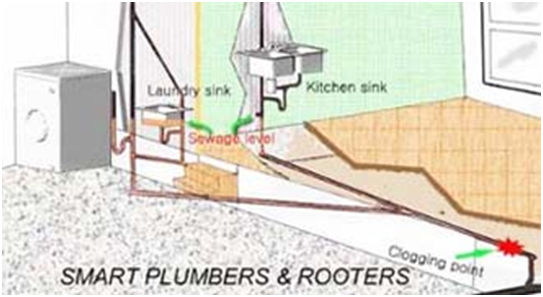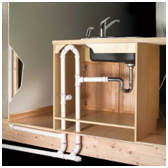The kitchen sink is often the most used fixture in your home. Just think about how many times a day you use it. Add in the amount of food debris, grease, oils and other things we send down our kitchen sink drain line and it is no wonder when it finally stops up and becomes clogged.
Typical residential kitchen sink drain lines are 2” in diameter and usually made of cast iron metal (in older homes) or ABS plastic (in newer homes). Kitchen sink drain lines can sometimes be combined with a washing machine or laundry drain line which joins together under the concrete floor or crawl space of the home.

Some homes have a kitchen sink that sits in the middle of the room, this is referred to as an island sink. These types of sinks require special types of venting referred to as an island loop vent because there is no wall for the vent to be installed. This drain system requires 2 cleanout drain access points for proper drain cleaning.


Vent piping in a drain system is very important because it breaks the vacuum created when water is flowing. Without a proper vent system, the drain line may not drain properly and appear to be clogged when in fact it is a rotted or blocked vent line. It is a good idea to have the plumbing vents cleaned every few years to make sure they are clear. A sewer camera will allow for inspection of the condition of your sewer line.
There are many preventative maintenance things a homeowner can do themselves:
(see blog page for more ideas)
- Pouring a cup of bleach down the drain, let sit for 5 minutes then rinse. This will help to remove odors and help keep the drain clear.
- Fill the bowls then pull the plug! When you run the faucet, water only drains in the bottom portion of the pipe, debris can start to accumulate along the top and sides of the pipe and before you know it your drain is stopped up and clogged. By filling the bowl and draining, water produces a swirling motion filling the piping and washing away debris and build up even on the top and sides of the pipe.
- Run hot water for a few minutes after washing dishes or cleaning the sink. This will help dissolve and rinse away debris.
PROPER WAY TO USE A GARBAGE DISPOSAL
- Turn the disposal on with NO WATER RUNNING.
- Introduce debris you want to dispose of into the garbage disposal.
- Let the disposal GRIND the debris for approximately 15 seconds
- Turn on COLD WATER
- Let disposal grind for another 15 seconds
- Turn off disposal and let the water run for 15 seconds to wash debris to the main sewer line.
Complete Plumbing Heating and Air have everything needed to tackle even the toughest problems with kitchen sink drain lines. We have high pressure water jetters, sewer pipe bursting, sewer liners, cameras, sewer locators
